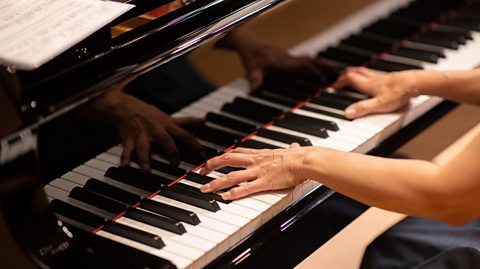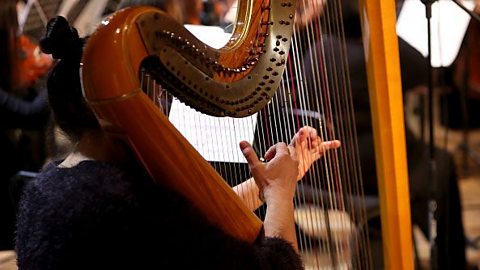Key points about Love of My Life

Queen were a well-known British rock band known for their close-harmony singing and guitar solos.
Love of My Life was written by Freddie Mercury in 1975. It is said that he wrote it about his girlfriend at the time, Mary Austin.
Like Bohemian Rhapsody, Love of My Life is from QueenвҖҷs 1975 album A Night at the Opera. It is a pop ballad.
A pop ballad usually tells a story and has sentimental lyrics. The tempo is usually slow and pop ballads usually feature a piano accompaniment of either broken chords or block chordsMore than one note being played at once..


Remember
Love of My Life is one of the three songs which are the study pieces for Area of Study 2 for your AQA GCSE listening exam.
The other two are:
Who were the members of Queen?

From left to right:
Roger Taylor - drums, vocals
Freddie Mercury - lead vocals, piano
Brian May - lead guitar, vocals
John Deacon - bass guitar
Video
Watch the video below to find out more about the structure, vocal, instrumental and other musical features of Queen's Love of My Life.
Presenter: The rock band Queen formed in 1970 and this ballad, Love of My Life, was written by lead singer Freddie Mercury. It's on the 1975 album A Night at the Opera and is believed to be about his long term relationship with Mary Austin. As well as vocals, the band includes piano, guitar, drums, and bass.
This song starts with a piano solo. It's in F major with a 4/4 time signature and a steady tempo of 80 beats per minute. It has a typical song structure of a verse, followed by a chorus. The piano is joined by the acoustic guitar.
And surprisingly, the harp with glissandi glides from one note to another, played by the guitarist Brian May.
Unusually, the chorus features a 3/4 bar.
Singers 1: Because you don't know what it means to me.
Presenter: The instrumentation reflects the emotional themes of this love song, as do the altered chords like FвҷҜm7вҷӯ5, G7sus4, and Cmaj7. But you couldn't have a Queen here without a Brian May instrumental solo. Here he is, accompanied by classical style ornamented melodies on the piano.
The song finishes as it started, with Freddie Mercury's vocals in harmony with a piano and a final harp glissando.
Singer 2: Love of my life. Love of my life.
Singers: Oh, oh.
Structure
The structure of the song is verse-chorus.
| Section | Tonality |
|---|---|
| Introduction: Bars 1-7 | F major (implied) B flat major (temporary modulation) in the second phrase |
| Verse 1 and 2: Bars 8-31 вҖҳLove of my lifeвҖҷ | Starts in C major, modulates to F major вҖҳ(canвҖҷt you) see?вҖҷ |
| Instrumental bridge: Bars 31-35 | B flat major, this is similar to the second phrase of the introduction |
| Interlude: Bars 36-44 вҖҳYou will rememberвҖҷ | D minor (relative minor), moves to G minor (passing modulation) |
| Guitar solo: Bars 45-58 | Starts in F major, moves to C major, then B flat major |
| Coda: Bars 59-67 вҖҳBack, hurry backвҖҷ | D minor, finishes in F major |
Vocal features

The vocals and the way they are used are a hallmark of QueenвҖҷs style. MercuryвҖҷs solo voice stands out as he sings most of this song in the male upper range, the tenor voice.
As is typical of ballads, he sings by himself in verse one and is joined by backing vocals in verse two. The backing vocals interject, emphasise specific words and also sing backing вҖңooohsвҖқ.
The close harmony is also typical of QueenвҖҷs style. Some of the harmonies are falsetto A singing method used by males (usually tenors) to achieve notes higher than those that are in the вҖҳnormalвҖҷ range..
After the guitar solo the song returns to a solo voice.
In the coda the solo and backing vocals come together to close the song.


Remember
A notable feature in this song is the harp, which is played by Brian May. The orchestral harp is not usually found in rock bands. Brian May learnt to play it himself.
Question and answer
What is the structure of Love of My Life?
The song follows a verse-chorus structure.
Instrumental features
The instruments in this song include piano, an orchestral harp, an electric guitar and a bass guitar.
What influences can be heard in the piano part?
- The piano often plays trills, typical of music from the Baroque and Classical period.
- The homophonic/broken block chords are typical of a ballad accompaniment.
- The use of the sustain pedal adds tonal colour.

How is the harp used?
- The harp uses glissandi - gliding from one note to another - spread chords in the introduction and the coda.

How do guitars feature in Love of my Life?
Electric guitar:
- It enters briefly at the end of the instrumental bridge and links it to the interlude.
- In the guitar solo, there are slides, glissandi or portamento.
- Bends are also used.
Bass guitar:
- Used in its low register in verses one and two.
- In the instrumental bridge and later on, it moves into a higher register.

In pictures: Queen's Love of my Life

Image caption, Brian May playing guitar in 1975 on A Night at the Opera tour.
Image caption, Brain May learnt to play the orchestral harp, which features in this song.
Image caption, Queen were known for the their close harmony vocals.
Image caption, Freddie Mercury was known for his distinctive vocals and was also the band's pianist.
Image caption, Mary Austin is said to be the subject of the ballad Love of My Life.
1 of 5
Other musical features
The other musical elements are:
| Harmony | Mainly diatonic, with chords changing once or twice a bar. There are some complex chords in the Interlude, including F#m7b5, and the only diminished 7th chord - F#dim7. |
| Texture | Melody and accompaniment. |
| Tempo | Moderately slow, typical of a ballad. 4/4 time, though in verses 1 and 2, there is one 3/4 bar, and in verse 2 there is a 6/4 bar before the instrumental bridge. |
| Dynamics | The song starts quietly, piano, and gradually builds to a forte guitar solo. |
Question and answer
How would you describe the tempo of most ballads?
Slow or moderately slow.
Quiz
More on Popular music
Find out more by working through a topic